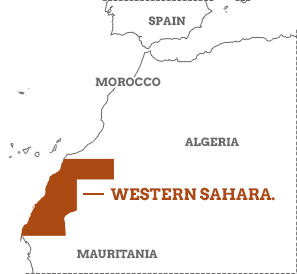Western Sahara map & highlights
There are two reasons to visit the non-self-governing Western Sahara territory. The first: you’re interested in emptiness. Few tourists explore this disputed, desert region. The majority of Western Sahara is currently under Moroccan occupation, inhabited by Moroccans, and often visited via Morocco. The culture of the original tribes – known collectively as the Sahrawi – is increasingly marginalised. Since the 1970s, many Sahrawi have been forced to live in permanent refugee camps in Algeria, having been pushed out of Western Sahara.


Its ochre palette is both beautiful and inhospitable – but it’s not the desert that is the main threat to existence here, but conflict, mining – and climate change, which expands the already limitless-seeming expanse.![]()

There’s another reason to come to the Western Sahara – and that’s because you know the seemingly empty desert is actually filled with wildlife. Safari here means discovery upon miraculous discovery by torchlight. Think like a fennec fox: sleep in the day, and stay up late for the chase. It’s not empty here, but full of surprises.
Read on in our Western Sahara travel guide.
Read on in our Western Sahara travel guide.
Western Sahara is…
a pleasant surprise for wildlife watchers.
Western Sahara isn’t…
for city culture – the beauty’s in the desert.
Western Sahara map and highlights
Sea – and sand sea: the Western Sahara makes much of its long coastline – where rich ocean currents support a great deal of sea life and a steady breeze enthrals the kite surfers at Dakhla. Most of the towns are on or near the coast. If you turn inland, you’ll find that the desert interior is near unnavigable without a good guide. The region is mostly desert, and a defining landmark is the world’s second longest conveyor belt, which transports mined phosphate across the country. A second line in the sand – the Berm – is a 2,500km wall separating the Polisario-controlled region of Saharawi from the region under Moroccan control.
Aousserd and surroundings
1. Aousserd and surroundings
Inland from the coastal town of Dakhla, Aousserd is a small settlement that makes a great base for wildlife watching. In the Western Sahara, people often spot wildlife that is not so easily seen elsewhere. Driving out on the tar and sand roads, you might see animals at rest in the daytime heat – look for rare and elusive sand cats, fennec foxes and African golden wolves.
Dakhla
2. Dakhla
If you’ve made it down to Dakhla, the last town before Mauritania, you’ve travelled far into Western Sahara. Set on a skinny peninsula, this modern town makes much of its double shoreline and bay. Kitesurfers garlanding the horizon make the most of the reliable breeze, coming onshore to stay in purpose-built hotels. Off the coast is a big fishing area – Dakhla is particularly known for its oysters.
Dakhla Bay
3. Dakhla Bay
Once home to a spectacular array of cetaceans, whose numbers have diminished thanks to overfishing, you can still see bottlenose and rare and unusual Atlantic humpback dolphins in Dakhla Bay on boat tours. The coast is good for looking out for terns, gulls and flamingos, as well as migrating wading birds. They shelter in Dakhla bay around the sandstone rocks and mud flats.
The desert
4. The desert
Sand dunes extend all the way to the horizon, white in the midday sun and golden by sunset. You’re on the edge of the Sahara, whose hostile climes don’t relent until you get south of Mauritania. Look down from sandscape and you’ll start to notice the details: canyons and herders’ wells, as well as many animals hidden in burrows and caves, awaiting cooler night-time temperatures.
Desert safaris
5. Desert safaris
Hippos and lions wouldn’t last long here. Instead, desert safaris show you specialised creatures adept at desert adaptation. If you want to see the most wildlife, go on a night drive. Mammals like Saharan striped polecats, African hedgehogs, and fennec foxes – many travellers’ most prized sighting – are far more active when the hot sun disappears. It’s time for a midnight feast for the eyes.
Laâyoune
6. Laâyoune
Laâyoune, built on the site of desert oases, is the principal town in Western Sahara. It’s a useful base for meeting your guides before onward travel into the desert. The administrative Western Sahara towns might lack history, but they can be colourful places. Women wear sari-type fabrics swept over their heads and bodies; the riot of colour choices is striking in the bleach-white midday sun.
Western Sahara overland tour, Marrakech to Bissau
Travel from North Africa through the Sahara to the tropics
From
£8599 to £9299
4 weeks
ex flights
Morocco and western Sahara tour
Amazing scenery and nomadic tribes in Morocco's deep south.
From
£3049 to £3199
12 days
ex flights
Sahara rare wildlife tour
Search for rare mammals in the Western Sahara
From
£2095
8 days
ex flights
Western Sahara desert wildlife tour
Spot Fennec foxes & Sand cats in the Sahara
From
£1995
8 days
ex flights
Contact Us

Call us for a chat about our holidays. We are happy to discuss your holiday and help in any way we can. No bots, queues or awful hold music.
01273 823 700
Call us until 6pm
Calling from outside the UK















